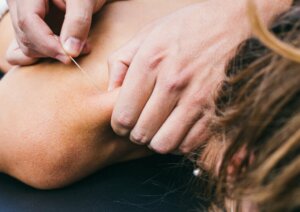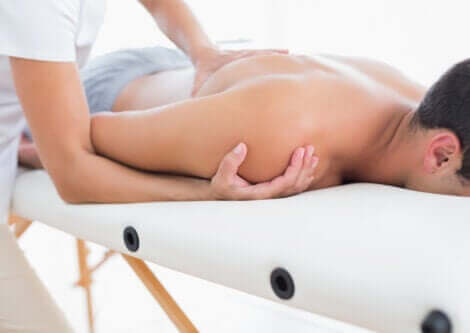How Can You Treat Muscle Cramps?

Knowing how to treat muscle cramps is useful for everyone, given the frequency with which these pains can occur. What measures can you take to relieve the symptoms of a muscle cramp?
Cramps and spasms are some of the most common muscle problems there are. People who train several times a week can suffer from them, but so can people who spend a lot of time sitting in front of a computer.
What are muscle cramps?
Muscle cramps happen when a muscle stays constantly contracted instead of relaxing. This permanent contraction has two main consequences.
On the one hand, pain. Muscles go through a cycle of contraction and relaxation to function, using various substances in the body. When the muscle doesn’t relax, it doesn’t have time to breathe, recover and absorb oxygen, which means that it’ll become sore.
Secondly, this contraction will also cause a notable reduction in the range of movement and the strength of the muscle. For any movement of your body, your muscles freely go from being relaxed to contracting; it’s that easy.
However, when a muscle is already contracted, it doesn’t go through the same process and can’t complete its actions. That’s why you won’t be able to move that muscle as much as you could normally, and also why it won’t have the strength that it normally would.
What’s more, the cramp will also reduce your mobility since the muscle can’t relax. Whenever you move, some muscles contract, and others stretch. If one muscle is contracted and can’t stretch out, it’ll limit your movements, even if it’s not directly involved.
Methods to treat muscle cramps
As we’ve seen, and also as an investigation published in the magazine Sports Medicine shows, muscle cramps are a frequent issue for athletes and they can cause pain and limited movement. With that in mind, how can you treat muscle cramps?

Here’s the good news. While they’re very frequent, muscle cramps can also be cured completely in the great majority of cases. It’s very rare for a muscle cramp to have repercussions later down the track or to reoccur, as long as you treat it appropriately.
Here are the principal methods for treating cramps:
Heat or cooling treatment
Treatments that involve temperature are the starting point for treating almost any muscle injury. If the injury is recent (within the last 24 to 48 hours), apply cold.
If the cramp is from more than two days earlier, you should use heat. Why is this? Well, during the first couple of days, applying cold helps to limit the damage of the cramp by reducing swelling. However, after that initial period, heat helps the blood to flow which in turn helps the muscle to recover.
Dry needling
Dry needling is a treatment technique that’s gained popularity over time thanks to its effectiveness. It involves using small acupuncture needles, which a therapist inserts into the patient’s skin.
Of course, this is a technique that must be carried out by a professional. Under no circumstances should you try it at home. The therapist will look for the ‘trigger points’ or painful spots with their needles, to cause different muscular reactions. These reactions, or spasms, make the muscle react and relax.
If you receive treatment, it’s likely you’ll leave the therapist’s office in a fair amount of pain. However, the next day, the cramp will be significantly better. The positive effects of this technique are confirmed in this study published in the International Journal of Environmental Research and Public Health.
Stretches and gentle exercises
If you’re looking to relax a tense muscle, one way to do it is by stretching it out. You should use specific stretches for that muscle and you should make sure to start slowly, doing the stretch in a controlled way. That is, you should stretch out the muscle slowly, taking note of its limits and giving it time to adapt as you gradually stretch it further.
It’s also a good idea to do gentle exercises and get the injured muscle to start working. Think of activities such as walking, Tai Chi, etc. These types of exercises make the large muscle groups move, preferably in all directions and also gently.
Massage to treat muscle cramps

The other technique you can take advantage of if you have a muscle cramp is going to a physiotherapist for a massage. Apart from relaxing the muscle itself, the therapist will also seek and treat the specific trigger points.
Variety is the spice of life
As with many other injuries, the best way to treat muscle cramps is with a varied approach. If you apply heat and stretch, so much the better. If you go see a therapist and they recommend dry needling or a massage, that’s also great. However, if you can use each of the four different options above, that would be ideal.
As we mentioned above, recovery of a muscle cramp should be complete. If you just use one or two of the treatment options but it keeps bothering you, ask for help. It might be a more severe cramp where it’s not enough just to use a heat pack in the afternoons, for example. The most important action is to treat it appropriately so it doesn’t become chronic, which then means it’ll limit you further in your daily life.
Knowing how to treat muscle cramps is useful for everyone, given the frequency with which these pains can occur. What measures can you take to relieve the symptoms of a muscle cramp?
Cramps and spasms are some of the most common muscle problems there are. People who train several times a week can suffer from them, but so can people who spend a lot of time sitting in front of a computer.
What are muscle cramps?
Muscle cramps happen when a muscle stays constantly contracted instead of relaxing. This permanent contraction has two main consequences.
On the one hand, pain. Muscles go through a cycle of contraction and relaxation to function, using various substances in the body. When the muscle doesn’t relax, it doesn’t have time to breathe, recover and absorb oxygen, which means that it’ll become sore.
Secondly, this contraction will also cause a notable reduction in the range of movement and the strength of the muscle. For any movement of your body, your muscles freely go from being relaxed to contracting; it’s that easy.
However, when a muscle is already contracted, it doesn’t go through the same process and can’t complete its actions. That’s why you won’t be able to move that muscle as much as you could normally, and also why it won’t have the strength that it normally would.
What’s more, the cramp will also reduce your mobility since the muscle can’t relax. Whenever you move, some muscles contract, and others stretch. If one muscle is contracted and can’t stretch out, it’ll limit your movements, even if it’s not directly involved.
Methods to treat muscle cramps
As we’ve seen, and also as an investigation published in the magazine Sports Medicine shows, muscle cramps are a frequent issue for athletes and they can cause pain and limited movement. With that in mind, how can you treat muscle cramps?

Here’s the good news. While they’re very frequent, muscle cramps can also be cured completely in the great majority of cases. It’s very rare for a muscle cramp to have repercussions later down the track or to reoccur, as long as you treat it appropriately.
Here are the principal methods for treating cramps:
Heat or cooling treatment
Treatments that involve temperature are the starting point for treating almost any muscle injury. If the injury is recent (within the last 24 to 48 hours), apply cold.
If the cramp is from more than two days earlier, you should use heat. Why is this? Well, during the first couple of days, applying cold helps to limit the damage of the cramp by reducing swelling. However, after that initial period, heat helps the blood to flow which in turn helps the muscle to recover.
Dry needling
Dry needling is a treatment technique that’s gained popularity over time thanks to its effectiveness. It involves using small acupuncture needles, which a therapist inserts into the patient’s skin.
Of course, this is a technique that must be carried out by a professional. Under no circumstances should you try it at home. The therapist will look for the ‘trigger points’ or painful spots with their needles, to cause different muscular reactions. These reactions, or spasms, make the muscle react and relax.
If you receive treatment, it’s likely you’ll leave the therapist’s office in a fair amount of pain. However, the next day, the cramp will be significantly better. The positive effects of this technique are confirmed in this study published in the International Journal of Environmental Research and Public Health.
Stretches and gentle exercises
If you’re looking to relax a tense muscle, one way to do it is by stretching it out. You should use specific stretches for that muscle and you should make sure to start slowly, doing the stretch in a controlled way. That is, you should stretch out the muscle slowly, taking note of its limits and giving it time to adapt as you gradually stretch it further.
It’s also a good idea to do gentle exercises and get the injured muscle to start working. Think of activities such as walking, Tai Chi, etc. These types of exercises make the large muscle groups move, preferably in all directions and also gently.
Massage to treat muscle cramps

The other technique you can take advantage of if you have a muscle cramp is going to a physiotherapist for a massage. Apart from relaxing the muscle itself, the therapist will also seek and treat the specific trigger points.
Variety is the spice of life
As with many other injuries, the best way to treat muscle cramps is with a varied approach. If you apply heat and stretch, so much the better. If you go see a therapist and they recommend dry needling or a massage, that’s also great. However, if you can use each of the four different options above, that would be ideal.
As we mentioned above, recovery of a muscle cramp should be complete. If you just use one or two of the treatment options but it keeps bothering you, ask for help. It might be a more severe cramp where it’s not enough just to use a heat pack in the afternoons, for example. The most important action is to treat it appropriately so it doesn’t become chronic, which then means it’ll limit you further in your daily life.
All cited sources were thoroughly reviewed by our team to ensure their quality, reliability, currency, and validity. The bibliography of this article was considered reliable and of academic or scientific accuracy.
- J. Pachas. Punción seca en terapia física. Artículo realizado en la Universidad Inca Garcilaso de la Vega. 2020
- J. González. Lesiones musculares y deporte. Revista Brasileira de Medicina do Esporte, 4(2), 39-44. 2018
- P. Jami, M. Cevallos y T. Vilema. Tratamiento comparativo entre la técnica de crio masaje terapéutico en seco (CTS) y el tratamiento convencional en pacientes que presentan contractura muscular a nivel Cervico-dorsal que acuden al centro de rehabilitación física y kinesiológica (Cenrefic) en el período de noviembre 2013 – abril 2014. Tesis en la Universidad Nacional de Chimborazo.
This text is provided for informational purposes only and does not replace consultation with a professional. If in doubt, consult your specialist.








